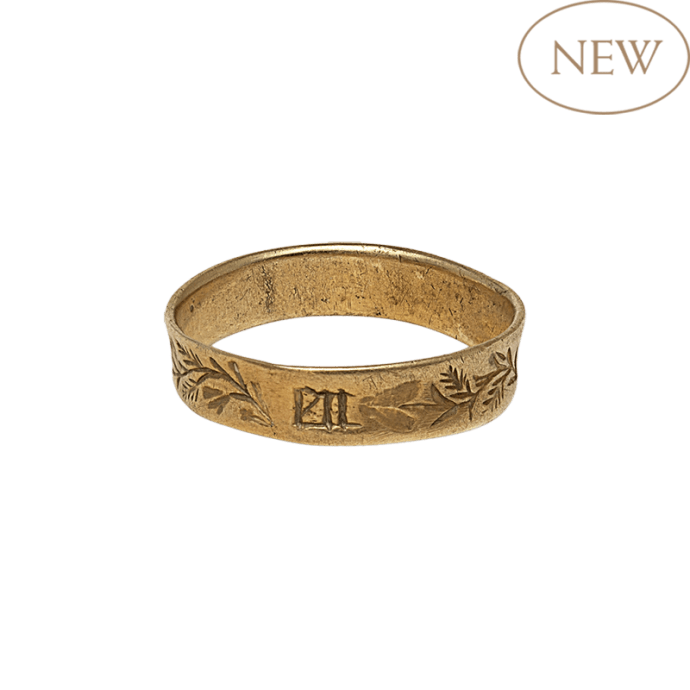Gold ring with flat band, slightly concave, plain on the interior and on the exterior engraved in French with black letters “en/bon/dieu” (roughly translatable to “with God” or “by the grace of God”). Interspersed between the words of the inscription are chased and engraved hearts and foliate lily sprays. The ring shows signs of age and is in good wearable condition.
Provenance:
United Kingdom, The Jonest Collection, published by Diana Scarisbrick and Sonja Butler, Marvels in Miniature, The Jonest Collection of Rings, London 2024, p. 79, n. 47.
Literature:
The term “posy ring” derives from the “poesie” or poetry and describes rings with mottoes either in prose or verse. On earlier rings, like here, the message is visibly engraved in gothic letters on the exterior and known as “black letter rings.” Later the motto was often concealed inside the hoop and its personal content only known to the giver and recipient. Posy rings find mention in plays by William Shakespeare (1564-1616), such as Hamlet and the Merchant of Venice, and they enjoyed great popularity throughout the seventeenth and eighteenth centuries, especially as betrothal or wedding rings. Through the centuries they were also known to be exchanged between lovers, friends and family members expressing affection, friendship, faith, or even a Happy New Year.
Here the motto “en bon dieu” in combination with the hearts and lily sprays probably alludes to the union of the couple, a blessing from God for love and happiness in their future married life. In Christian iconography the lily became the attribute of the Virgin Mary, symbolic of purity and chastity, with many examples to be found throughout paintings dating to the same period as this ring. With time the iconography persisted and solidified further, with later painting depicting Christ Child handing lilies to saints.
The posy motto on this ring is rare. In the compendium Evans 1931, pp. 57-58 quotes God and Christ in a similar context, but not with the same wording. cf. similar fifteenth-century posy rings in London museums: British Museum (Dalton 1912, nos. 925, 939, 970, 971), Museum of London (inv. nos. A22158; A24240); Victoria and Albert Museum (Church 2017, p. 15, fig. 7 and inv. nos. M.57-1946). See also Scarisbrick 2007, nos. 88, 89; Scarisbrick 2021, no. 10 (Griffin Collection). The inscriptions on these examples include mainly messages of love and wishes for a good year.
For a history of posy rings with extensive examples ranging from the medieval period to eighteenth century, see: Scarisbrick 2021, and for further information on posies: Evans, 1931; Anon., A Garland of Love: A Collection of Posy-Ring Mottoes, London 1907; Dalton 1912, pp. 174 ff.; Scarisbrick 2007, pp. 74 ff., Taylor and Scarisbrick 1978; Oman 1974, pp. 39 ff.
R-1090













